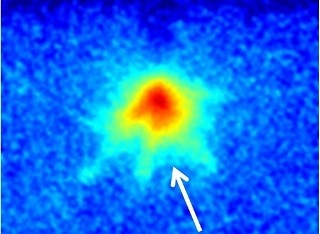Dec 12 2017
Silicon microelectronics and biomedical domains could gain from a safe and economical way to synthesize nanoparticles.
 A thin, pancake-shaped plasma cloud formed at oil–water interfaces can be used to synthesize exotic nanomaterials. Reproduced with permission from reference 1.© 2016 AIP
A thin, pancake-shaped plasma cloud formed at oil–water interfaces can be used to synthesize exotic nanomaterials. Reproduced with permission from reference 1.© 2016 AIP
Water and oil do not combine, but a research team at KAUST has exploited the different interfaces between these substances to make plasma generation in liquids more efficient 1,2. This method has potential for use in high-yield synthesis of nanomaterials from liquid reagents or for regulated elimination of water-borne parasites.
Common versions of plasmas in TV displays and neon signs use stable, charged particles in a gaseous state. But when created in water from nanosecond bursts of electricity, positive ions in the plasma cool down considerably compared to energetic hot electrons. The resulting non-thermal discharges can transfer energy to or from nearby molecules, making them potential influencers of chemical reactions.
Ahmad Hamdan, a postdoctoral researcher with Min Suk Cha, is aiming to broaden the impact of in-liquid plasmas by reducing common breakdown voltage requirements. Firstly, he and his coworkers injected miniature gas bubbles into liquids to upset the usual electric field and form regions of amplified intensity to tear charges apart. Regrettably, this plan tended to trap the hot electrons within the bubbles, separating them from prospective chemical targets.
These studies, however, exposed the variations in dielectric permittivity, a parameter that impacts how electric fields propagate in materials, played a crucial role in bubble-based field improvement. Hamdan understood that this occurrence could be reproduced by dipping an electrode into two liquids with diverse responses to electric fields-a layer of low-dielectric heptane oil on top of water, for instance.
By enhancing the electrode's position within the oil-water interface, Hamdan discovered he could produce plasmas in the liquids with 100% probability at lower than normal voltages. Furthermore, the plasma propagates along the interface with a five-fold improvement in discharge volume.
"This is interesting because the plasma is capable of decomposing both liquids without eroding the electrode," notes Hamdan. "This gives us the flexibility to try and turn a wide range of substances into novel nanomaterials."
As a demonstration, the team swapped the heptane layer with hexamethyldisilazane oil comprising nitrogen, silicon, and hydrocarbon atoms. When the nanosecond electrical discharges were applied to this oil-water interface, organosilicon nanoparticles were created at rapid rates-several milligrams per minute-safely confined inside the liquid medium. Additional post-processing produced species adequately stable for high-temperature microelectronic devices.
Vital to this research was the transmission electron microscopy offered by Dalaver Anjum at the Imaging and Characterization Core Lab of KAUST, which proved critical for determining relationships between silica nanoparticles of varying sizes and their dielectric properties. Additionally, a special electron prism on the microscope offered element-by-element breakdown of separate nanoparticle compositions.
The applications of this research are extensive. "We have demonstrated only part of the potential feasible applications," says Cha. "This novel idea can be extended to water purification, biomedical applications, and upgrade of low-quality liquid fuels; we will continue to work to make these applications tangible.
References
1. Hamdan, A. & Cha, M. S. Low-dielectric layer increases nanosecond electric discharges in distilled water. AIP Advances 6, 105112 (2016).| article: http://aip.scitation.org/doi/10.1063/1.4966589
2. Hamdan, A., Halim, R. A., Anjum, D. & Cha, M. S. Synthesis of SiOC:H nanoparticles by electrical discharge in hexamethyldisilazane and water. Plasma Processes and Polymers, e1700089 (2017).| article: http://onlinelibrary.wiley.com/doi/10.1002/ppap.201700089/abstract